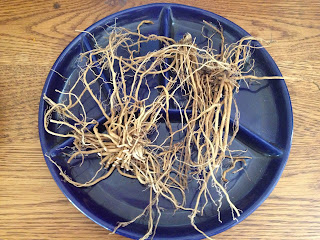Herbal Apothecary: Valerian Tincture
About six weeks I ago I harvested some valerian root from the garden and set it out to dry:
I had been warned by many sources that valerian smells terrible and only gets worse as it dries. I also heard that it attracts cats, but neither of these things have turned out to be true. Fletch has never even given it a sniff, despite it being at nose height for a couple of weeks.
As for the smell, it does have an odor — I just don't happen to hate it. It's very hard to describe. It reminds everyone of something, but no one can seem to place it. There's definitely a camphor scent to it — kind of turpentine-y or Mentholatum-y — that lingers in the back of your sinuses. There's also an earthy, root-y smell to it, like a medicinal version of sarsaparilla. And, sometimes, there's a whiff of stinky socks involved, but that's not ever foremost in the bouquet for me, though apparently other people find it unbearable.
Since I had two trays of roots, I decided to try two different methods of preservation. I left the plate above to continue drying, which is a long process as roots are much thicker than leaves and flower petals.
For the other tray, I decided to try making a tincture. A tincture is basically the essential oils and compounds of a root or herb preserved in alcohol. It lasts pretty much forever, and is easy to mix with other ingredients. It's also really easy to make.
1. Gather the tools:
For this I used a wide-mouth pint jar, a standard reusable lid, and a large reusable lid.
2. Fill the jar about half way with clean, dry valerian root:
I really packed them in to reduce the amount of airspace left in the jar.
3. Get your hands on some 100 proof vodka:
This turns out to be a bigger challenge than I anticipated, as most stuff at the liquor store was only 80 proof. Since we're working to preserve plant matter, the alcohol content is important, so I was glad to finally find some in the way back of the store.
4. Fill the Mason jar to the bottom of the threads with vodka:
Now's a good time to use the handle of a wooden spoon to press out any air bubbles that might be lingering within all those roots.
5. To create a good seal that keeps the root under the liquid (and not exposed to air, which can cause it to spoil), I turn the standard size mason jar lid upside down and press it into the alcohol, wedging it into the jar:
You know you have a seal when a little of the alcohol runs over the lid and fills it just a bit.
6. Screw the wide-mouth lid onto the jar:
Now you just keep it somewhere good and dark, like the basement. Shake it once in a while, and cheek it in six weeks.
7. In six weeks, it looks like this:
It's about the color of root beer, which it kinda sorta is. Except now it smells like a verrrrry strong alcoholic version of that smell I couldn't describe earlier. Not gonna lie, the scent filled up the whole house as I worked on the next steps.
8. Strain the tincture:
Just pour the alcohol through a cheesecloth-lined funnel and into a clean glass. Be sure to squeeze the liquid out of the roots as well. Then rinse the mason jar, and strain it again, this time from the glass back into the jar.
When it's done, put the lid back on:
So, what's the point of all this? Well, valerian has been used for centuries as a muscle relaxer and sleep aid, and was also suggested for menstrual cramps. It has been called Poor Man's Valium, and was prescribed during the Blitz to help Londoners keep calm and carry on.
(It should be obvious to all that I am not a doctor, and make no recommendations about this for you.)
I can't report about its effectiveness yet, although I did taste a spoonful before closing the lid. It tastes like it smells: like a weird root beer medicine with a shit-ton of alcohol in it. I have no doubt that a tablespoon of this will help me sleep the way the alcohol in Nyquil does that same trick.
But right now I am enjoying good health and am sleeping well at night unaided, so it may be a while before I am able to report back with any results.













Comments
Post a Comment